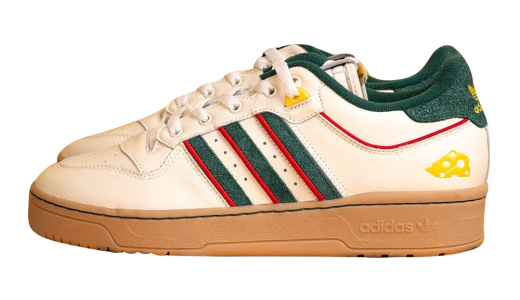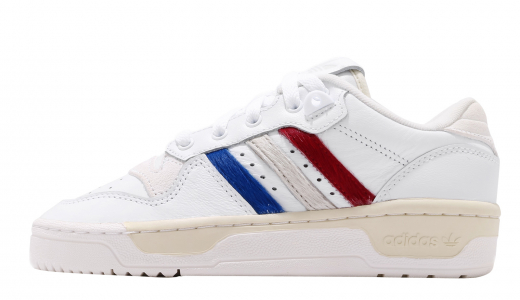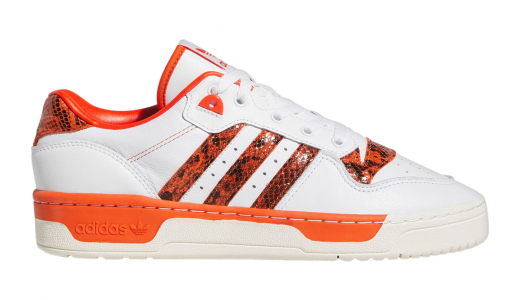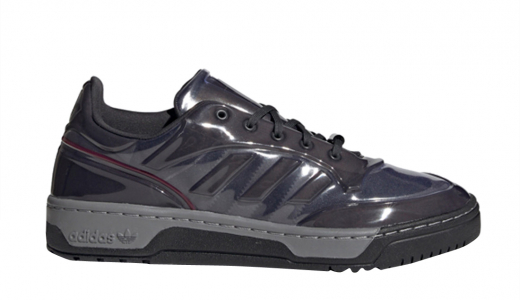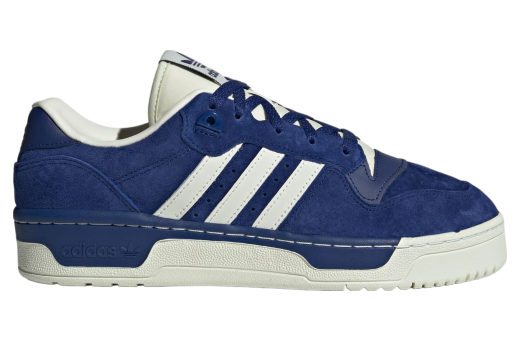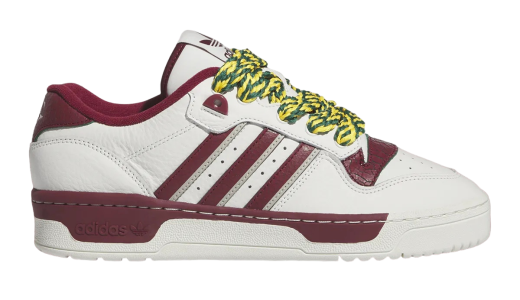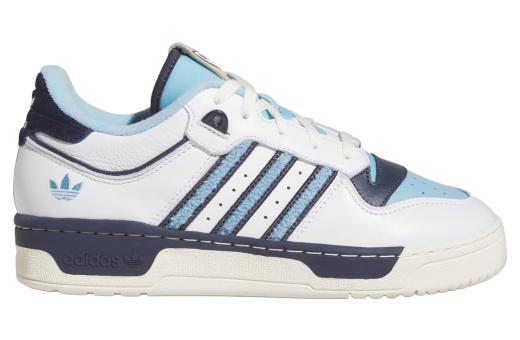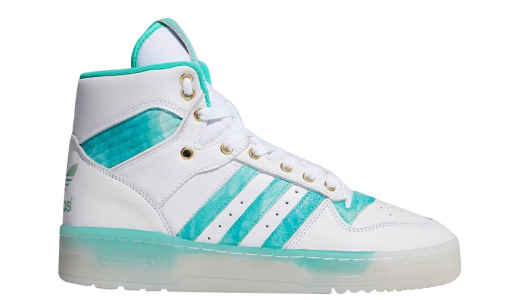Adidas Rivalry
The Adidas Rivalry sneaker, originally introduced in the 1980s, holds a significant place in the annals of sports and streetwear history. This iconic shoe made its debut during an era when basketball was rapidly gaining popularity, and it quickly became a favorite on and off the court. Designed initially for performance, the Rivalry featured a robust leather construction that provided durability, combined with a high-top design for ankle support. Adidas capitalized on the rich cultural intersection of athletics and urban fashion, crafting a sneaker that resonated with both athletes and style-conscious individuals. Its association with famous basketball players elevated its status, cementing its place as a symbol of prestige and coolness during its heyday.
In contemporary times, the Adidas Rivalry has made a notable resurgence as a retro classic, embraced by a new generation of sneaker enthusiasts and nostalgic fans alike. The modern iterations of the Rivalry manage to retain the authentic design elements that made it a hit in the 80s while incorporating subtle updates to meet current fashion and performance standards. This revival speaks to the enduring appeal of the original design and its timeless aesthetic. Moreover, the Rivalry’s legacy is further extended through numerous collaborations with designers and artists, illustrating its versatility and ability to stay relevant in the ever-evolving landscape of sneaker culture.
History of Adidas Rivalry
The Adidas Rivalry: A Historical Panoramic
Origins and 1980s: The Birth of an Icon
In the early 1980s, the burgeoning world of basketball experienced a confluence of emerging talent and an ever-increasing popularity. This was the golden era of sports gear innovations, and shoes were as much a part of an athlete's identity as their accolades and accomplishments. Within this rich tapestry of sporting excellence, Adidas sought to cement its place in the basketball court through a distinctive creation—the Adidas Rivalry.
Design and Innovation
The Adidas Rivalry was unveiled in 1986, designed explicitly as a high-performance basketball shoe. At the core of the Rivalry's creation was an emphasis on functionality blended masterfully with an aesthetic appeal. The Adidas design team, known for their meticulous approach and dedication to quality, engineered the Rivalry to include a combination of durable leather for the upper, providing both flexibility and support, essential attributes for the dynamic nature of basketball movements.
During the conceptualization phase, the shoe's striking silhouette, featuring a high-top design, was focused on offering ankle support, a critical aspect for basketball players susceptible to injuries. The inclusion of the Adidas three stripes on the side served as both a branding emblem and structural reinforcement. The shoe also showcased a classic rubber outsole with an intricate herringbone pattern, furnishing superior grip on the basketball court.
Cultural Resurgence and the Role of Patrick Ewing
One cannot traverse the history of the Adidas Rivalry without acknowledging the contributions of NBA player Patrick Ewing. Ewing was one of the most dominant centers of his era, known for his powerful presence both on the court and in popular culture. As a premier athlete headlining the Adidas last minute 'sign' in August 1985, Ewing exemplified the qualities Adidas wanted to project with the Rivalry: strength, resilience, and a relentless drive to excel.
His endorsement was a strategic move to cement the Rivalry's standing in the basketball shoe echelon. Ewing's exceptional career, which saw him don the New York Knicks jersey from 1985 to 2000, was intricately linked with the image of the Rivalry, amplifying its visibility and desirability. The shoe became a symbol of basketball prowess, influencing many young, aspiring athletes.
Technological Advancements: The Impact on Performance
The Adidas Rivalry wasn't just a shoe; it was a confluence of cutting-edge technology and sports-specific requirements. While maintaining its aesthetic appeal, Adidas was dedicated to infusing the Rivalry with elements that would enhance performance. They incorporated cushioning systems that provided shock absorption, crucial for high-impact sports like basketball. The combination of EVA (ethylene-vinyl acetate) and polyurethane provided a blend of comfort and durability, ensuring the shoe retained its form and functionality through rigorous play.
Moreover, ventilation was another focus area. The Rivalry featured perforations in the toe area, which allowed for better airflow, keeping the athlete's feet cooler and reducing the risks of blisters and other discomforts. By integrating these technologies, Adidas ensured that the Rivalry was not only an attractive option from an aesthetic standpoint but also a reliable partner in an athlete's sporting journey.
Cultural Icon: The Transition from Court to Street
As the 1980s transitioned into the 1990s, the demographic appeal of the Adidas Rivalry expanded beyond the realms of purely sports and into street culture. The intertwining of sports and urban culture was a burgeoning phenomenon, and the Rivalry found itself at the heart of this dynamic shift. The shoe's classic design and its association with basketball legends made it a desirable piece of streetwear.
The Adidas Rivalry became a staple in the underground hip-hop and skateboarding scenes. Its design—originally intended to support the high-impact actions of basketball—proved equally effective for the rigors of skateboarding. Furthermore, its stylish aesthetic made it an icon in the hip-hop community, where fashion and functionality often merge to create enduring trends. Music videos from influential artists frequently showcased the Rivalry, further embedding it in the cultural zeitgeist.
Re-releases and Modern Iterations
The enduring appeal of the Adidas Rivalry prompted Adidas to delve into its archives and re-release the classic model in various iterations over the decades. Each re-release was not merely a nostalgic nod to the past but also an opportunity to modernize the shoe with contemporary advancements in footwear technology.
For instance, in the early 2000s, Adidas introduced the Rivalry Lo, a low-top version that provided versatility for casual wear while retaining the original's core design elements. In the subsequent years, the brand introduced the Rivalry Boost, integrating its proprietary Boost technology. This modern rendition incorporated responsive cushioning, providing enhanced comfort while preserving the look that made the Rivalry an iconic shoe.
These re-releases ensured that each new generation was introduced to the historical legacy of the Rivalry while enjoying the benefits of modern sneaker technology. Collaborative projects with influential designers and brands also added unique twists to the Rivalry, expanding its appeal and maintaining its relevance in the ever-evolving sneaker landscape.
The Future of the Adidas Rivalry
In retrospect, the Adidas Rivalry is not merely a shoe; it is an emblem of convergence where sports performance meets cultural evolution. Its ongoing journey from hardwood courts to urban streets and then merging with modern collaborative scenes highlights the timeless allure of this iconic footwear.
Looking forward, the Adidas Rivalry is poised to remain a significant part of Adidas' heritage. In an industry where nostalgia plays a crucial role in shaping trends, the Rivalry is a symbol of Adidas' capability to blend history with innovation seamlessly. Future iterations and collaborations will likely continue to explore new materials, cutting-edge technology, and sustainable practices, ensuring that the Rivalry remains a relevant and revered part of sneaker history.
The legacy of the Adidas Rivalry is a testament to the brand's commitment to excellence and its ability to transcend mere functionality to create footwear that influences and becomes part of cultural narratives. Through the evolution of design, technology, and cultural significance, the Adidas Rivalry stands as an enduring icon, celebrated both on and off the court.
---
Conclusion
The story of the Adidas Rivalry shoe is one deeply rooted in the annals of sports history and cultural evolution. From its conception as a high-performance basketball shoe to its status as a streetwear icon, the Rivalry has traversed an extraordinary journey. Athletes like Patrick Ewing have cemented its place in sports legend, while its persistent allure in streetwear and pop culture underscores its indispensable role in the sneaker world. The Adidas Rivalry is a shoe that went beyond its functional inception to become an emblematic figure of sports, fashion, and cultural convergence, a timeless icon whose legacy will continue to inspire future generations.


